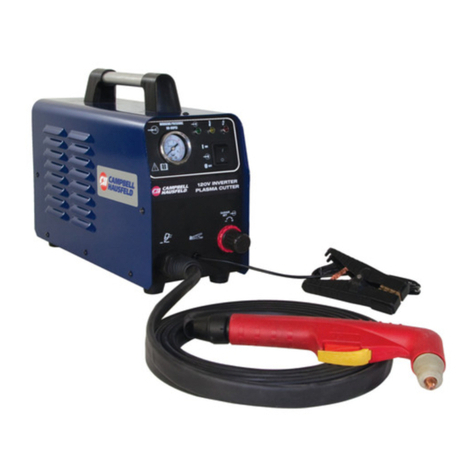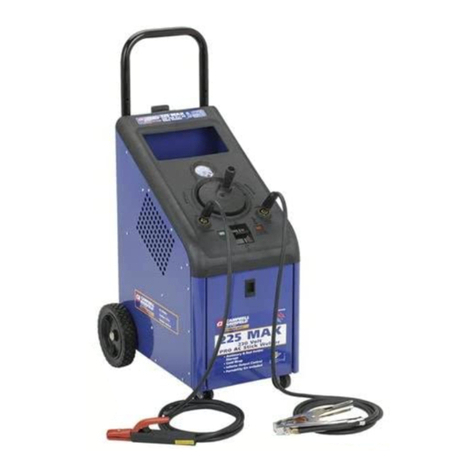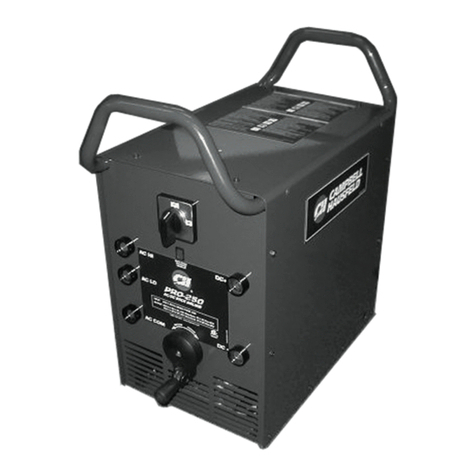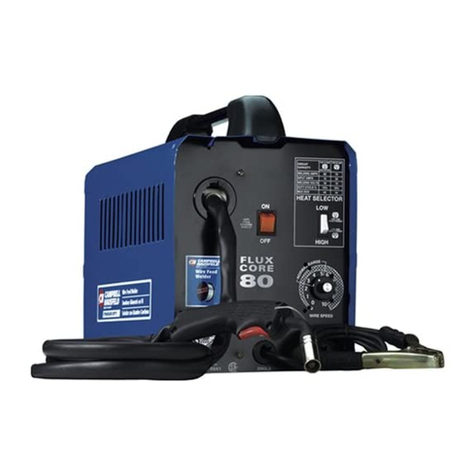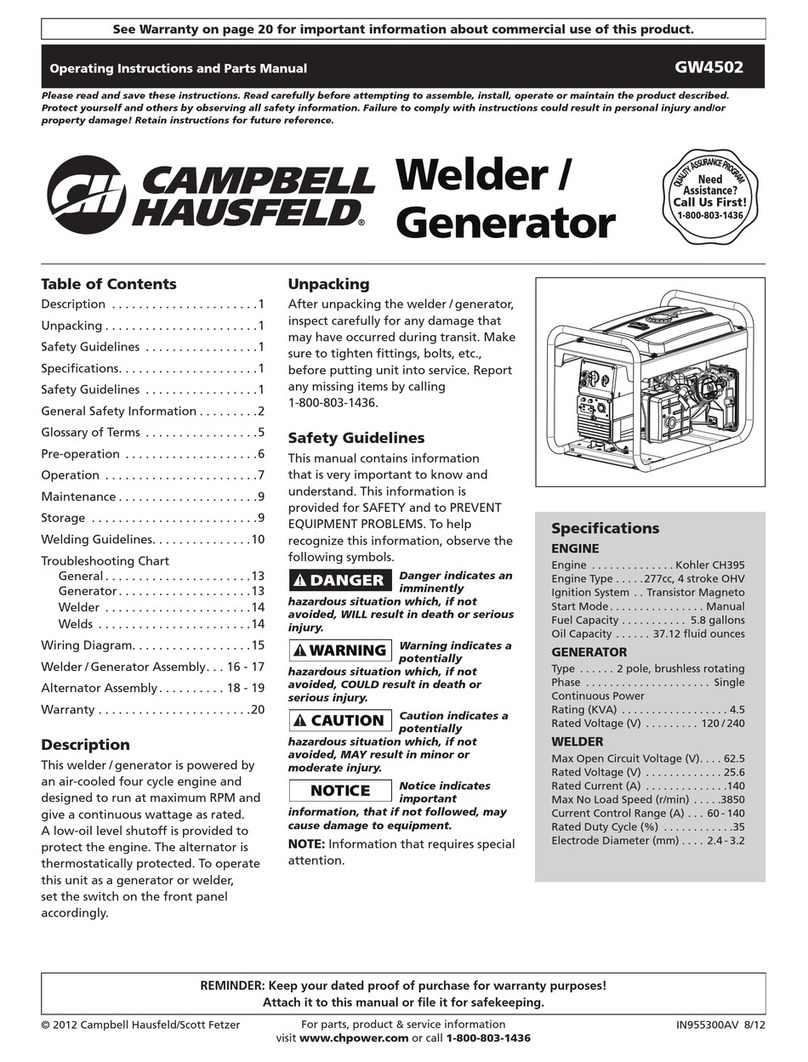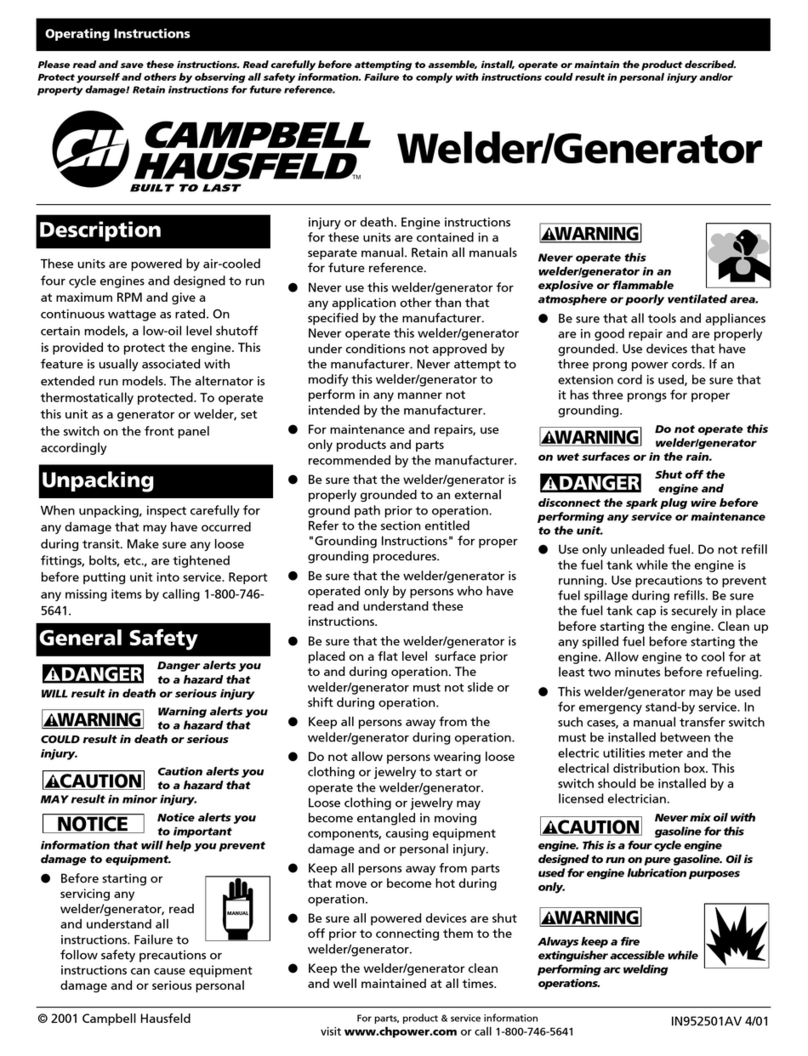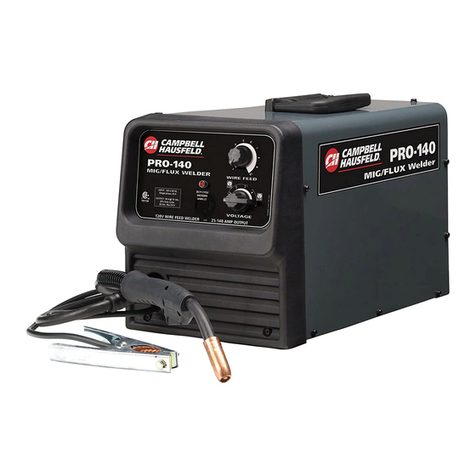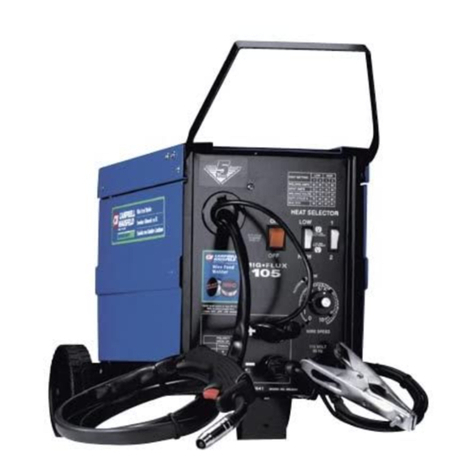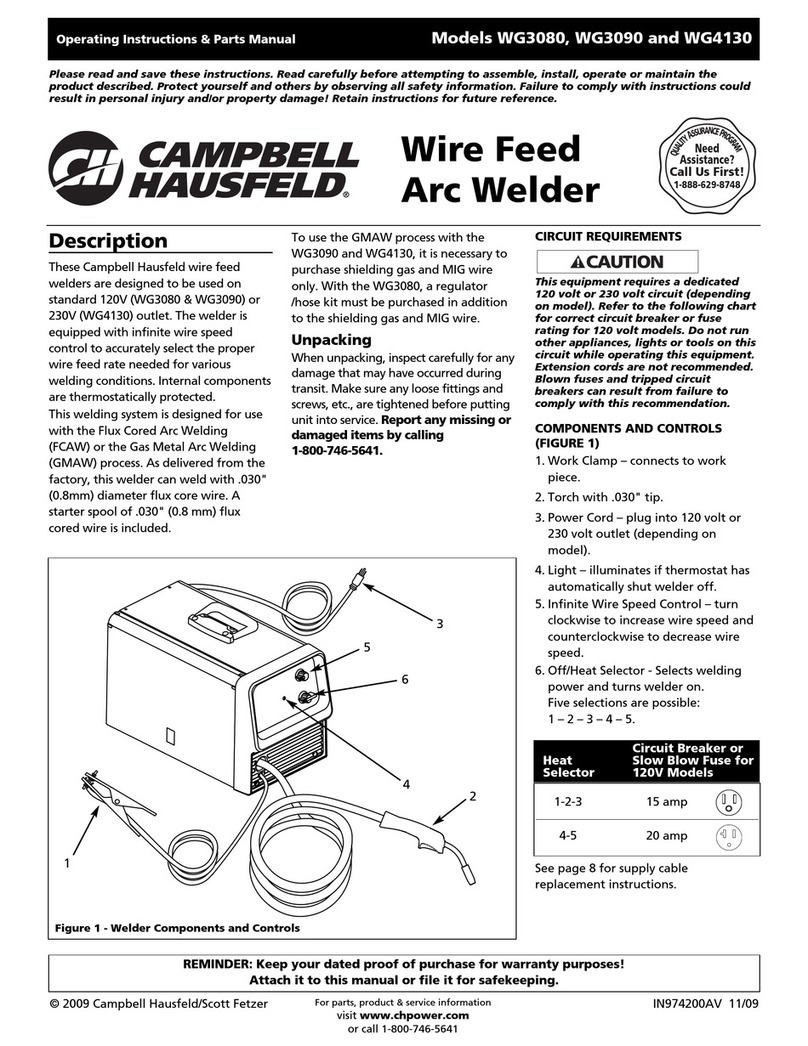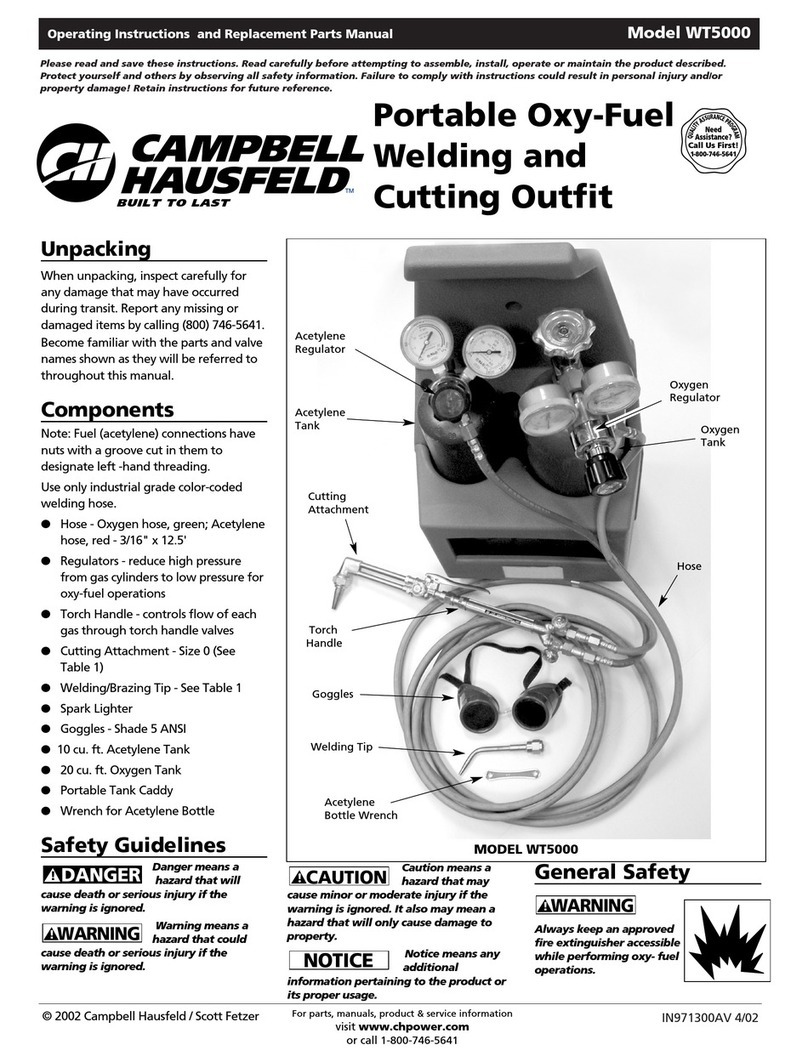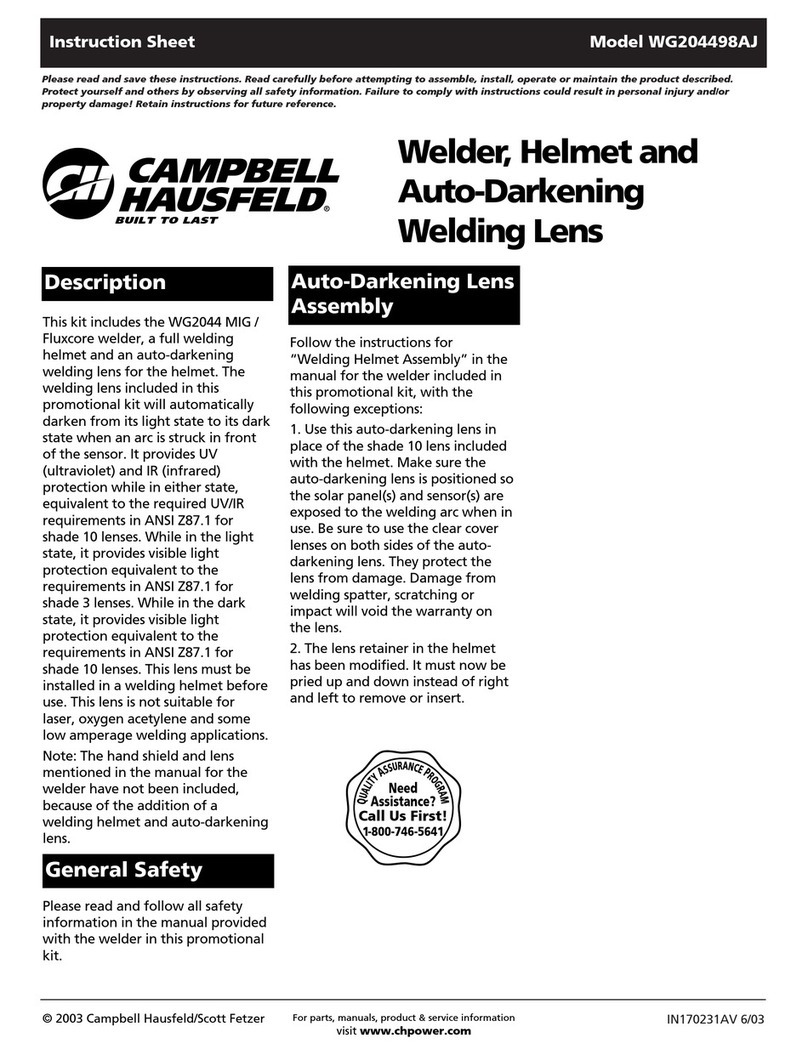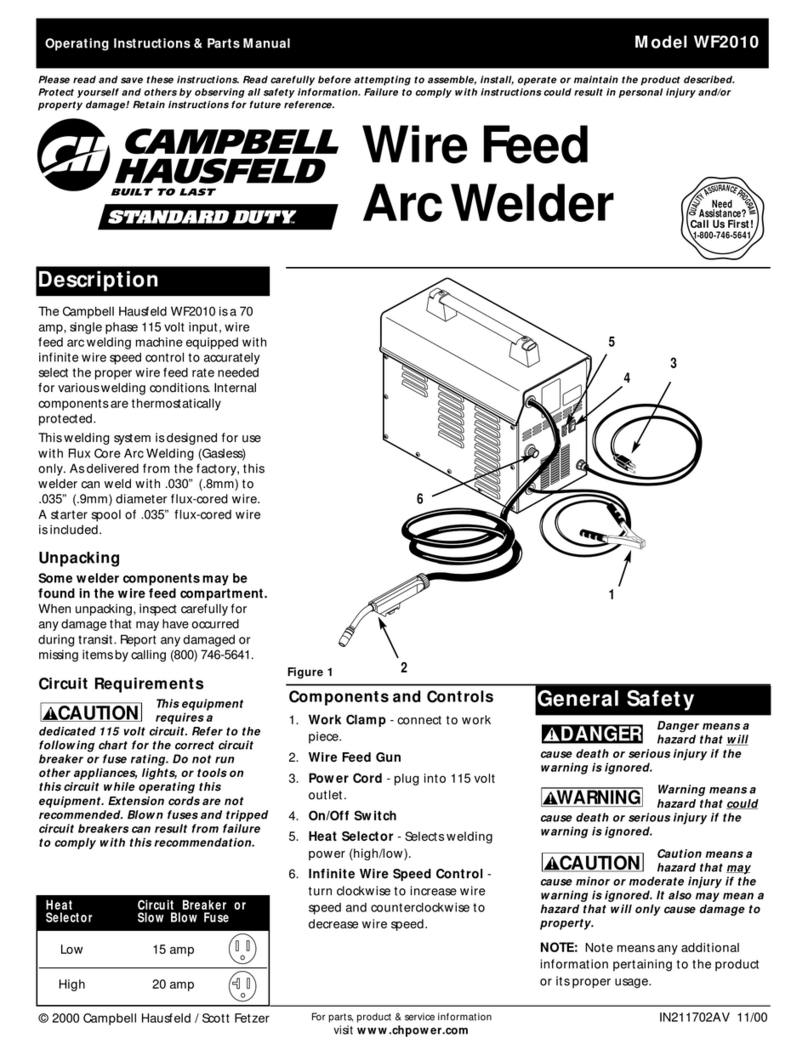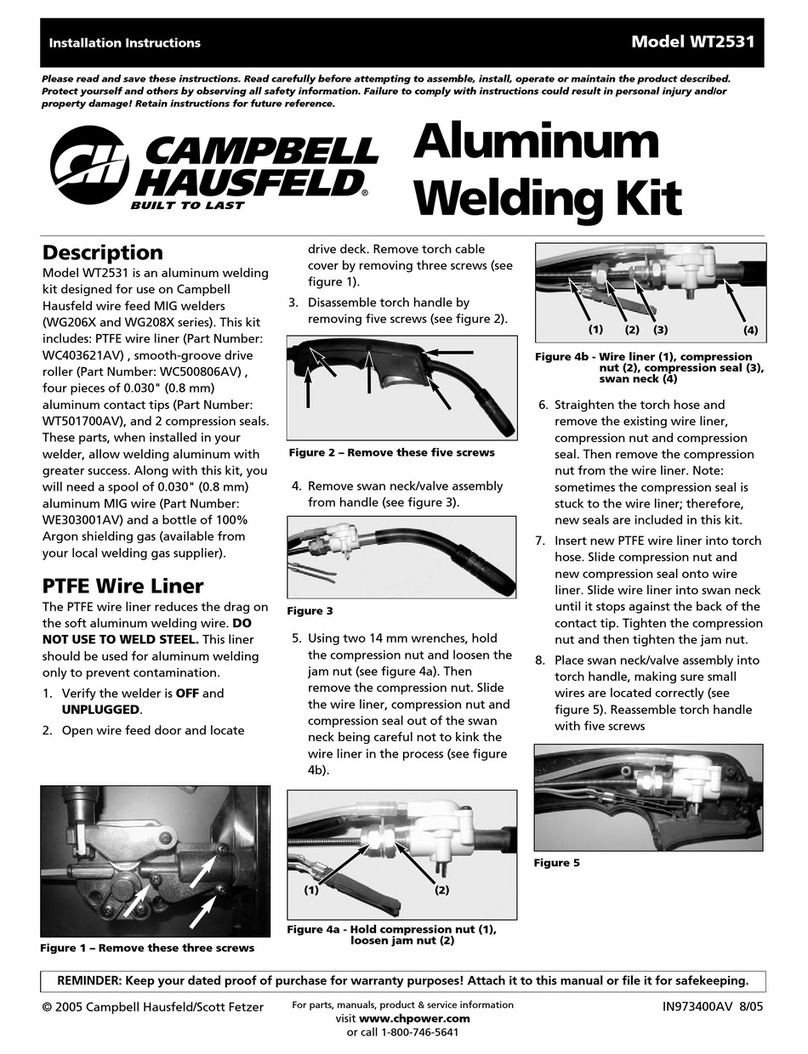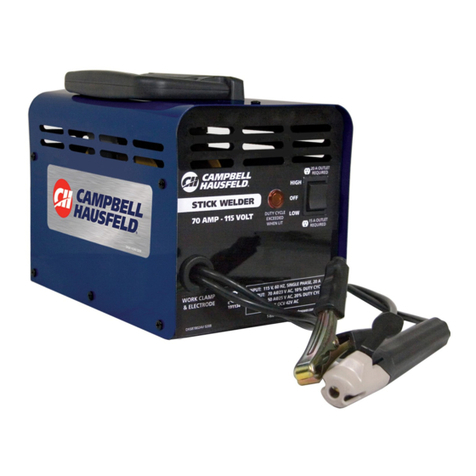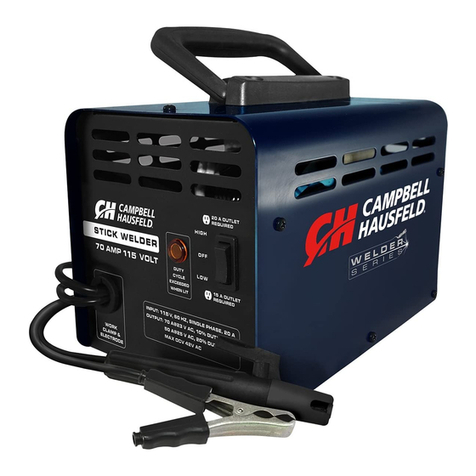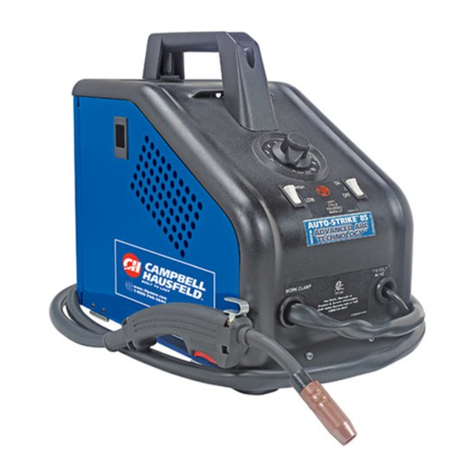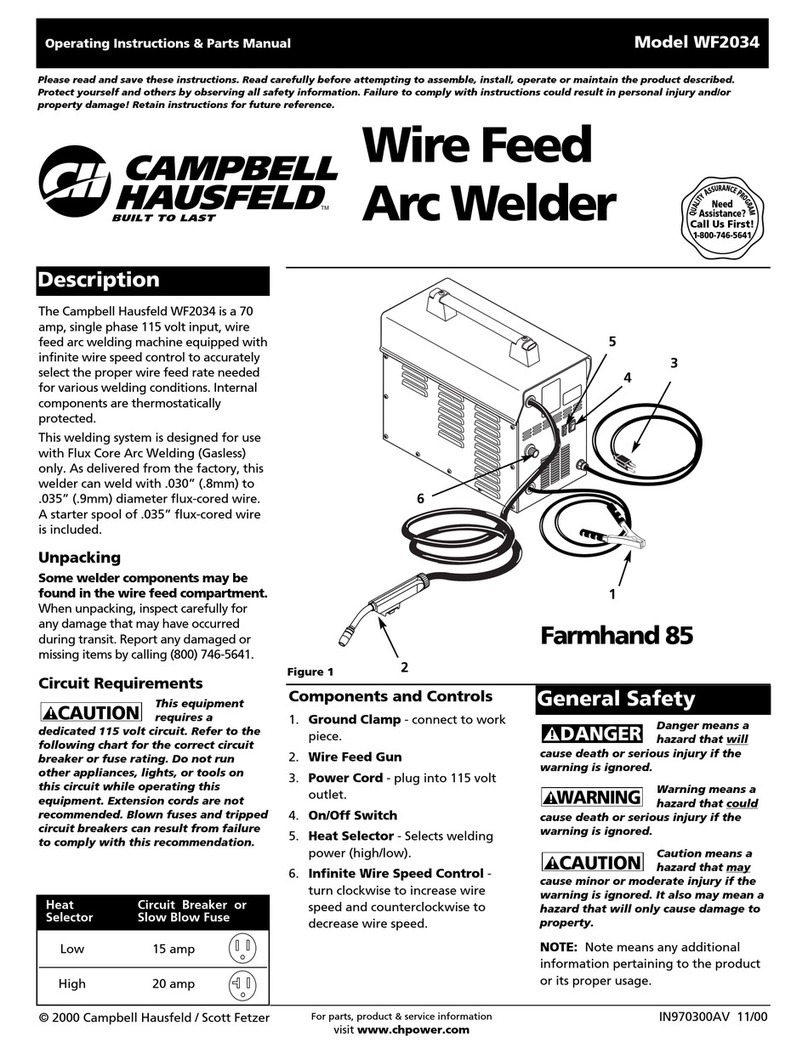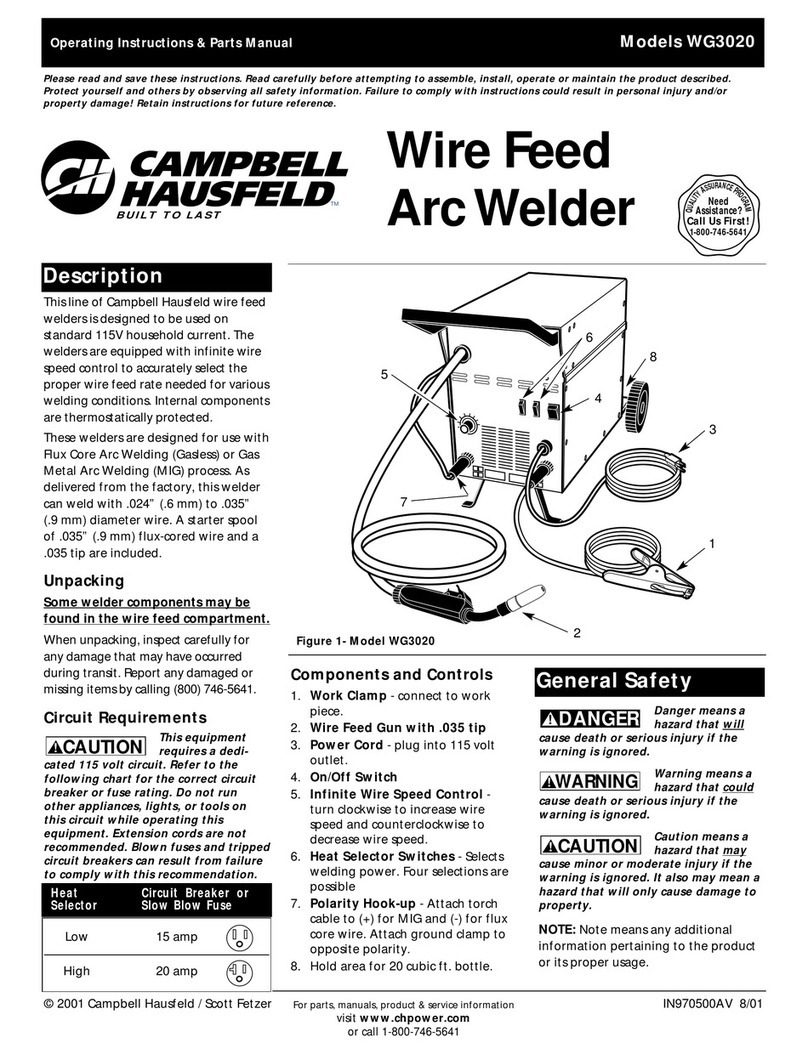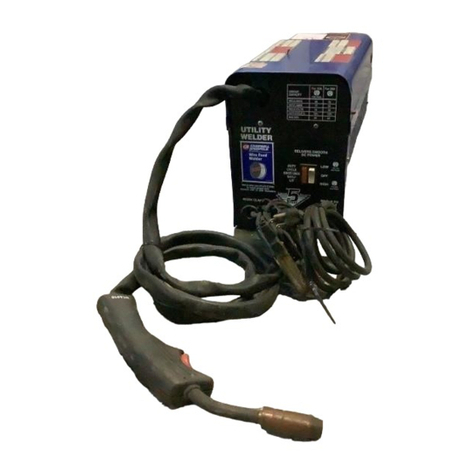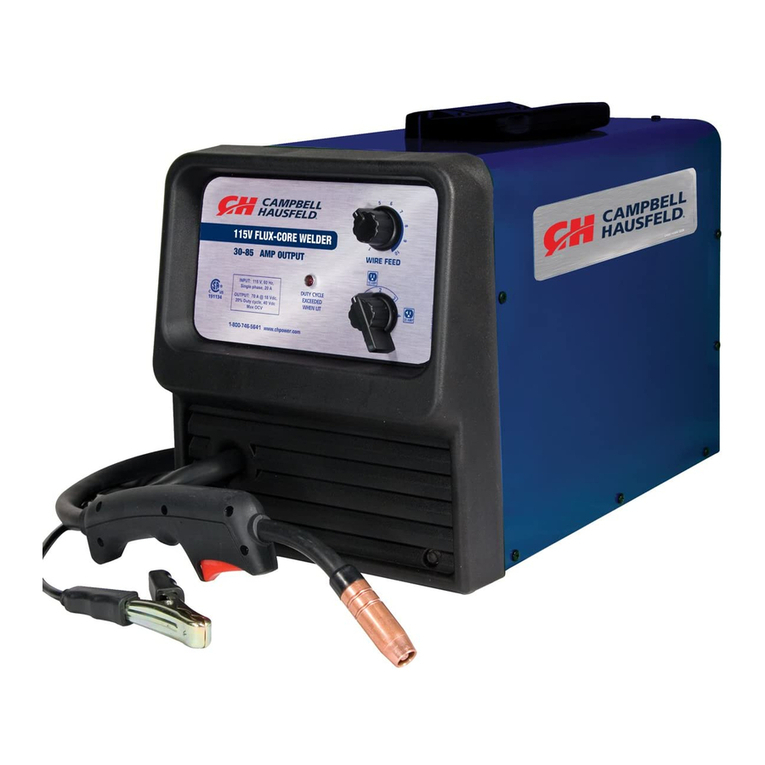
2
Installation Instruction Manual
Généralités Sur La Sécurité
Les
bou-
teilles peuvent exploser si endom-
magées. Les bouteilles de gaz cont-
iennent du gaz sous haute pression.
• Protéger les bouteilles de gaz
comprimé contre la chaleur
excessive, les chocs mécaniques et
les arcs.
• Installer et fixer les bouteilles dans
une position verticale en utilisant
une chaîne sur un support
stationnaire ou un support de
bouteille pour éviter le
renversement ou le basculage.
• Ne jamais permettre que
l’électrode de soudage touche une
bouteille.
• Tourner le visage à l’écart de la
sortie de la soupape pendant
l’ouverture de la soupape de
bouteille.
• Garder le chapeau protecteur en
place sur la soupape sauf si la
bouteille est soi en service ou
branchée pour service.
• Lire et suivre les instructions pour
les bouteilles de gaz et autre
équipement ainsi que la publication
CGA P-1.
Ne
jamais
utiliser les gaz inflammables avec les
soudeurs MIG. Seuls les gaz
inertes ou non-inflammables sont
convenables pour le soudage MIG.
Exemples: bioxyde de carbone.
argon, hélium ou un mélange d’un
ou plus de ces gaz.
Ne
ja-
mais soulever les bouteilles par
leurs soupapes, chapeaux ou avec
les chaînes ou élingues.
POLARITÉ
Pour le soudage à gaz, brancher le câble
du chalumeau dans la prise (+) et le
câble du collier de mise à la terre dans la
prise (-) du soudeur.
TYPES DE GAZ
Il y a 3 types de gaz populaires pour le
soudage à l’arc avec gaz; 100% argon,
un mélange de 75% argon et 25% gaz
carbonique (C25) ou 100% gaz
carbonique. Le mélange 75/25 est
recommandé pour le soudage général
(mais tous types peuvent être utilisés).
Pour le soudage d’aluminium, utiliser
100% argon. Fixer la bouteille en place
sur votre soudeur ou sur un autre support
pour éviter le basculage de la bouteille.
RÉGULATEUR
Ce régulateur a été conçu pour
l’utilisation avec le gaz Argon ou
mélange d’Argon. Un adaptateur
fileté est nécessaire si le gaz
carbonique est utilisé. L’adaptateur
est disponible chez votre marchand de
gaz pour soudage.
BRANCHEMENT
Les
bou-
teilles de gaz sont sous haute
!
AVERTISSEMENT
!
AVERTISSEMENT
!DANGER
!DANGER
pression. Diriger l’orifice d’échapp-
ement à l’écart de soi-mème ou
d’autres personnes avant de l’ouvrir.
1. Une fois que la bouteille est bien
installée, enlever le chapeau de la
bouteille, se tenir au bord opposé de
l’orifice d’échappement et ouvrir la
soupape un peu en tournant à la
gauche. Quand le gaz sort de la
bouteille, fermer la soupape en
tournant à la droite. Ceci sert à purger
la poussière qui peut s’accumuler
autour de la siège de soupape.
2. Installer le régulateur de gaz sur la
soupape de la bouteille de gaz et
serrer l’écrou avec sûreté à la soupape
de gaz.
3. Installer un bout du tuyau de gaz au
raccord situé en arrière du soudeur et
l’autre bout du tuyau au raccord du
régulateur en utilisant des colliers de
serrage sur chaque raccordement.
Assurer que le tuyau n’est pas tortillé.
4. Se positionner au bord opposé de
l’orifice d’échappement de la
bouteille et ouvrir la soupape
lentement. Inspecter pour des fuites
dans l’endroit des raccordements.
5. Ce régulateur est réglé d’avance à
30cfh. Aucun ajustement est
nécessaire. Un indicateur sortant
situé au bout du régulateur indique la
quantité de gaz restant dans la
bouteille. Si l’indicateur n’est pas
étendu, il rest approximativement 10
minutes dans la bouteille.
6. Fermer la soupape de gaz à la fin du
travail.
Informaciones Generales de
Seguridad
Los
cilindros
dañados pueden explotar. Estos
cilindros contienen gas a alta
presión. Si está dañado el cilindro
puede explotar.
• Proteja los cilindros de gas
comprimido contra calor excesivo,
golpes y arcos eléctricos.
• Instale los cilindros en posición
vertical y asegúrelos con una cadena a
alguna pieza fija o a la base para
evitar que se caigan o volteen.
• Nunca permita el contacto entre el
electrodo de soldar y los cilindros.
• Nunca mire directamente hacia la
válvula de salida cuando vaya a abrir
la válvula del cilindro.
• Mantenga la tapa de protección en la
válvula excepto cuando esté usando el
cilindro o esté conectado.
• Lea y siga las instrucciones sobre
cilindors de gas comprimido y equipos
relacionados disponibles en su país.
Nunca
use
gases inflamables para soldar con
soldadoras tipo MIG. Sólo debe usar
gases inertes o no inflamables con
las soldadoras MIG. Por ejemplo
puede usar argón, helio o mezclas de
algunos de estos gases.
Nunca
tome los
cilindros por las válvulas o tapas ni
!ADVERTENCIA
!PELIGRO
!PELIGRO
use cadenas o eslingas para
cargarlos.
POLARIDAD
Para soldar con gas , conecte el cable que
sale del soplete al tomacorrientes (+) y el
cable de la pinza para conexión a tierra al
tomacorrientes (-). Para soldar con
fundente revestido (sin-gas), conecte el
soplete al (-) y la conexión a tierra al (+)
de la soldadora.
TIPOS DE GASES
Hay 3 tipos de gases que generalmente se
usan para soldar con arco; 100% argón,
una mezcla de 75% argón y 25% dióxido
de carbono (C25) o 100% dióxido de
carbono. Todos se pueden usar, pero la
mezcla 75/25 es la recomendada para todo
tipo de soldaduras. Para soldadura de
aluminio, utilice100% de argón. En
cualquier tienda especializada en artículos
para soldar puede compar los cilindros de
estos gases. Cerciórese de que el cilindro
esté bien sujeto para evitar que se caiga.
REGULADOR/MEDIDOR DE FLUJO
Este regulador está diseñado para usarse con
Argón puro o mezclas de Argón. Deberá
utilizar una adaptador con roscas para usar
CO2. Este adaptador está disponible en
tiendas especializadas en el ramo.
PARA HACER LAS CONEXIONES
Los
cilin-
dros de gas están bajo alta presión.
Dirija la salida del cilindro en
sentido opuesto a Ud. u otras
personas antes de abrirlo.
1. Una vez que el cilindro esté bien
instalado, destápelo, párese al otro
lado de la salida y abra la válvula un
poco (gírela en sentido contrario a las
agujas del reloj) . Cuando comience a
salir gas del cilindro, gire la válvula en
el mismo sentido de las agujas del reloj
para cerrarla. Ésto eliminará cualquier
acumulación de polvo o basura que
haya en los alrededores de la válvula.
2. Instale el regulador/medidor de flujo
de gas en la válvula del cilindro y
apriete la tuerca del vástago para
conectarlo a la válvula del gas.
3. Instale uno de los extremos de la
manguera de gas al conector ubicado
en la parte posterior de la soldadora y el
otro extremo al conector del regulador
(use abrazaderas en cada extremo).
Cerciórese de que la manguera de gas
no esté enrollada o torcida.
4. Una vez más, párese al otro lado de la
salida y abra la válvula un poco. Revise
a ver si hay fugas.
5. Este regulador/medidor de flujo
viene fijado de fábrica a 30 pies
cúbicos por hora. No necesita
ajustarlo. Igualmente, un indicador
incorporado al extremo del regulador
le permite leer la cantidad de gas que
hay en el cilindro. Cuando este
indicador no está extendido, todavia
tendrá suficiente gas en el cilindro
para trabajar unos 10 minutos más.
6. Recuerde cerrar la válvula del gas
cuando termine de soldar.
!ADVERTENCIA
